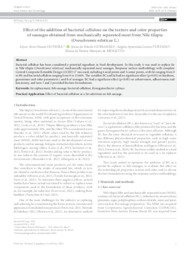Effect of the addition of bacterial cellulose on the texture and color properties of sausages obtained from mechanically separated meat from Nile tilapia (Oreochromis niloticus L.).
Effect of the addition of bacterial cellulose on the texture and color properties of sausages obtained from mechanically separated meat from Nile tilapia (Oreochromis niloticus L.).
Author(s): OLIVEIRA, A. A. N.; GUIMARAES, J. D.; FURTADO, A. A. L.; MESQUITA, E. DE F. M. DE
Summary: Bacterial cellulose has been considered a potential ingredient in food development. In this study it was used to replace fat in Nile tilapia (Oreochromis niloticus) mechanically separated meat sausages. Response surface methodology with complete Central Composite Rotatable Design (CCRD) 22 was used, including 4 axial points and 3 center points, with fat ranging from 0 to 8% and bacterial cellulose ranging from 0 to 13.66%. The variables BC and fat had no significant effect (p>0.05) on hardness, gumminess and color parameters c and h of sausages. BC had a significant effect (p<0.05) on cohesiveness, adhesiveness and luminosity, and tests 1 and 2 provided the best formulations.
Publication year: 2023
Types of publication: Journal article
Unit: Embrapa Food Technology
Observation
Some of Embrapa's publications are published as ePub files. To read them, use or download one of the following free software options to your computer or mobile device. Android: Google Play Books; IOS: iBooks; Windows and Linux: Calibre.
Access other publications
Access the Agricultural Research Database (BDPA) to consult Embrapa's full library collection and records.
Visit Embrapa Bookstore to purchase books and other publications sold by Embrapa.

